

23.12.2019
Ab dem 25.12.2019 werden in den frühen Abendstunden die Überflüge einzelner Starlink-Satelliten relevant, da sie jetzt wieder Richtung Zenit beobachtbar werden. Ihre Helligkeit ist beim Erscheinen auffallend und kann zu Überraschung bei klarem Himmel sorgen.
Nachfolgend ein paar Überflugdaten (25.-28.12.2019) welche als Beispiel für den Raum Darmstadt/Hessen bestimmt sind.
CENAP-Michelstadt
+++
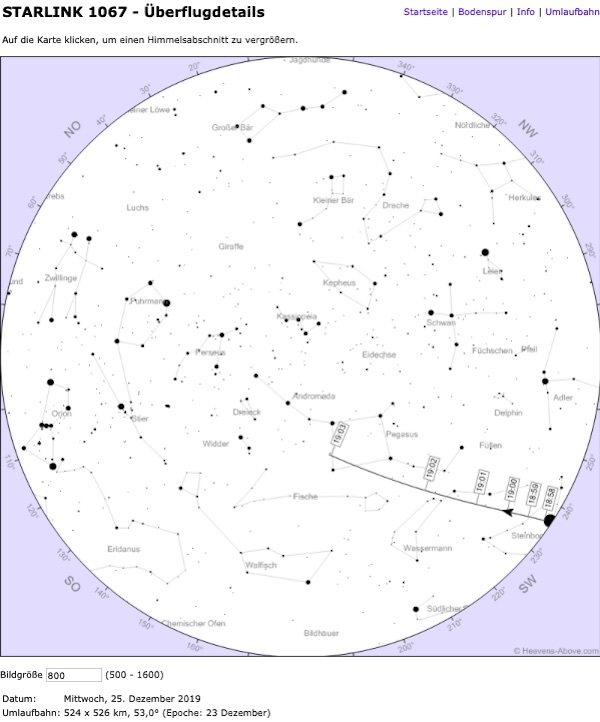
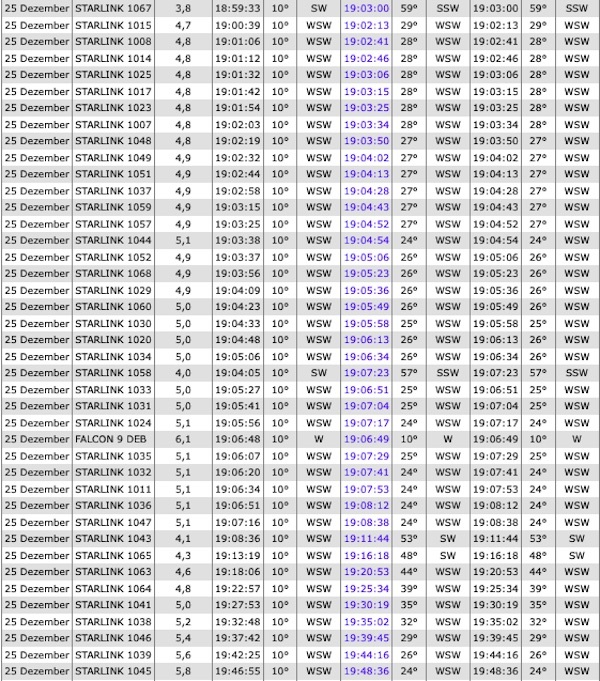



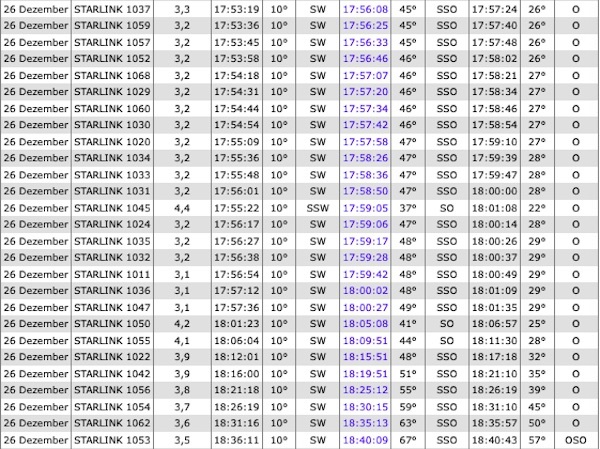



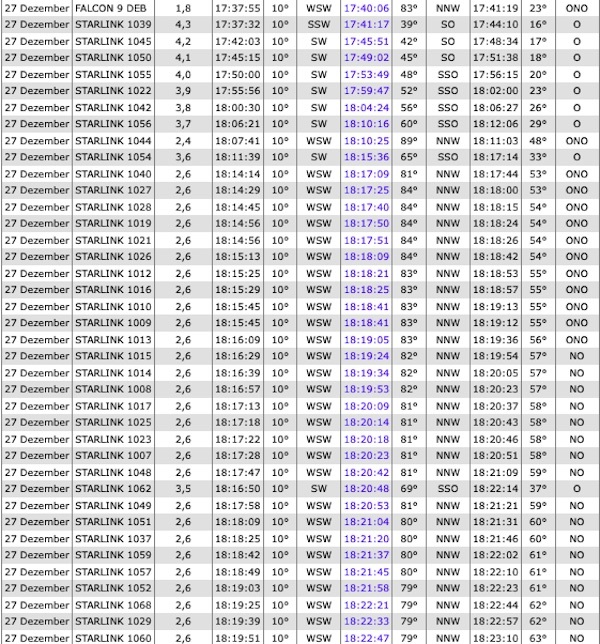


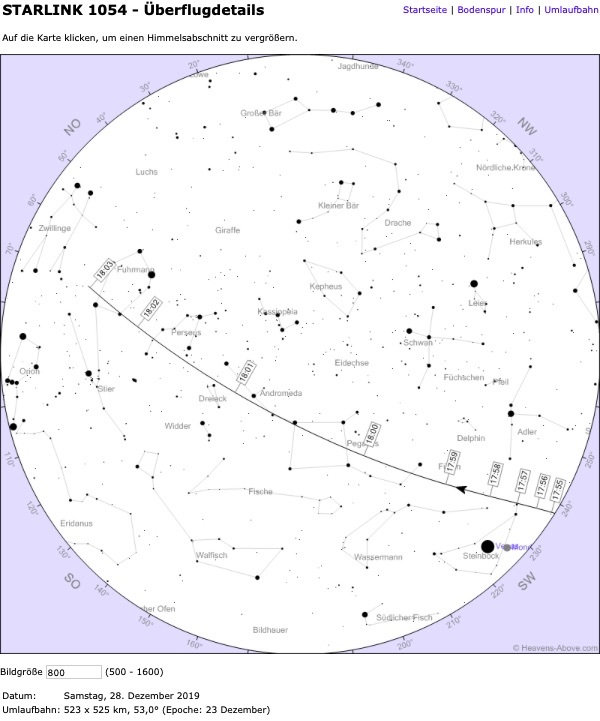

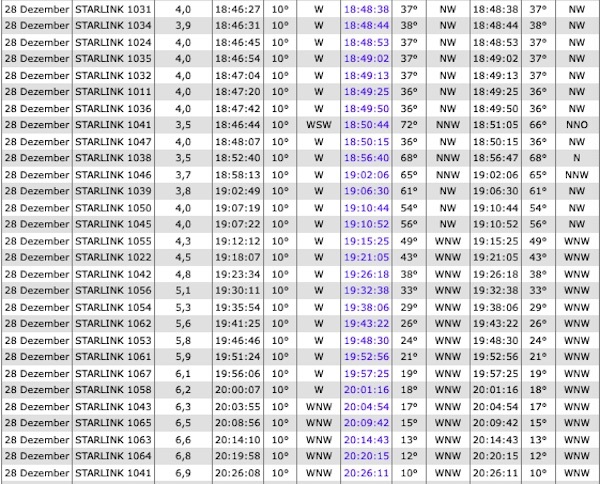
Quelle: Heavens Above
----
Update: 26.12.2019
.

26.12.2019
Gestern erreichten uns am frühen Abend die ersten Beobachtungen der Starlink-Satelliten per Kontaktformular sowie E-Mail und Tel-Anrufe aus dem süddeutschen Raum, wo scheinbar die Wolkendecke große Lücken hatte.
Beobachtungen gingen ein aus:
Neckarsulm, Güglingen, Bad Liebenzell, Dunningen, Lahr, Trossingen, Zaberfeld.
Fotos wurden uns zugesandt aus Neckarsulm und Güglingen, welche nachfolgend als Referenzaufnahmen zu sehen sind.
CENAP-Michelstadt, Stand 9.00 MEZ
.


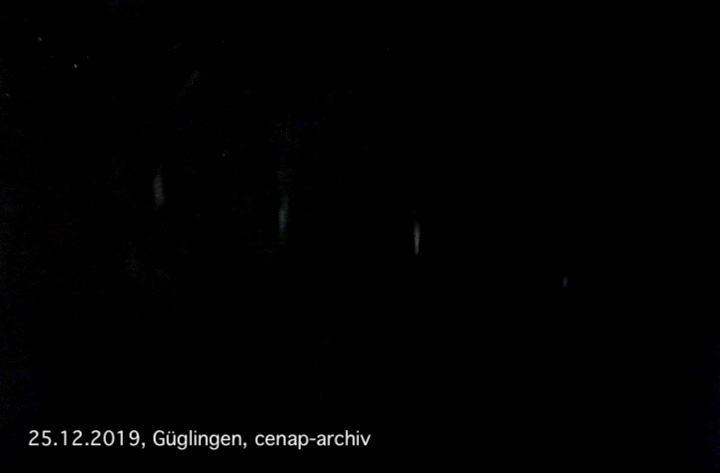
+++
Erste Presseberichte:

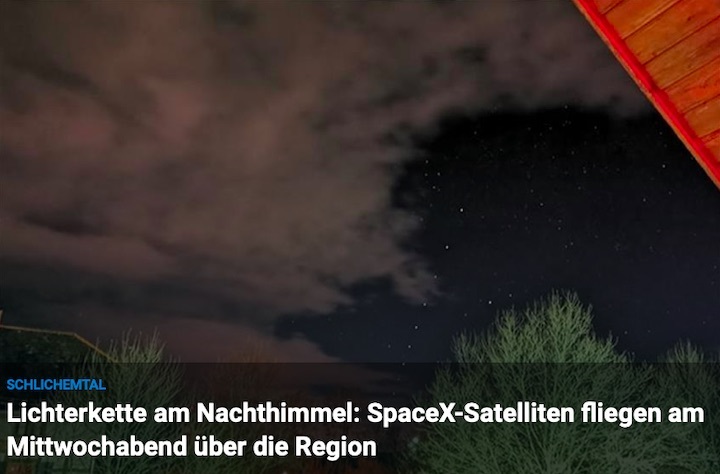
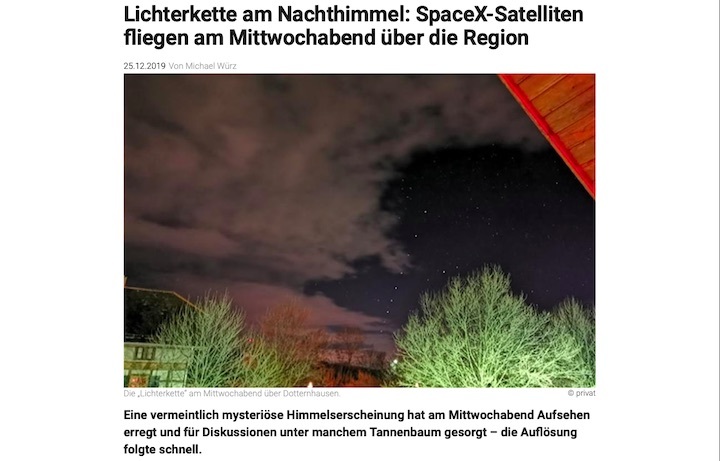

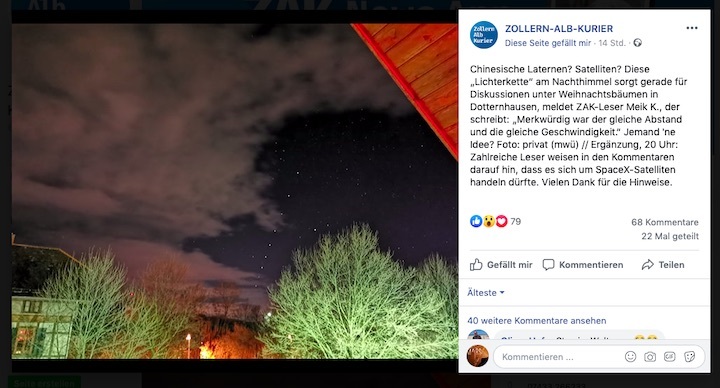

Quelle: zak.de
+++
Update: 18.00 MEZ
.

Über den Tag bekamen wir nachträglich noch Beobachtungsmeldungen von Gestern aus folgenden Orten:
Schramberg, Vöhrenbach, A93 bei Ausfahrt Ahrensberg mit Foto:
Sehr geehrter Herr Köhler,
die Aufnahme wurde gestern, am 25.12.2019 gegen 19 Uhr gemacht. Standort war der
Parkplatz an der A93, Ausfahrt Abensberg.
Die Qualität ist wie gesagt nicht ganz so prickelnd, aber ich denke man kann es erkennen.

+++
Heuteabend bekamen wir eine Meldung aus dem Raum südlich von Saarbrücken, wo es scheinbar gegenüber dem restlichen Bundesgebiet klaren Himmel hatte.
CENAP-Michelstadt
----
Update: 27.12.2019 / 13.30 MEZ
.

Da große Wolkenfelder über das Bundesgebiet bis heute Abend ziehen, wird es es spannend wo es Wolkenlücken gibt und man die Starlink-Satelliten etwaig erblicken kann. Zwischen 18 und 19 Uhr kommen sie heute auch recht hoch in Richtung Zenit und werden bei klarem Himmel sicherlich auffallen.
Siehe auch Oben die Überflug-Zeiten für Heute auf der Heavens Above Liste.
CENAP-Michelstadt
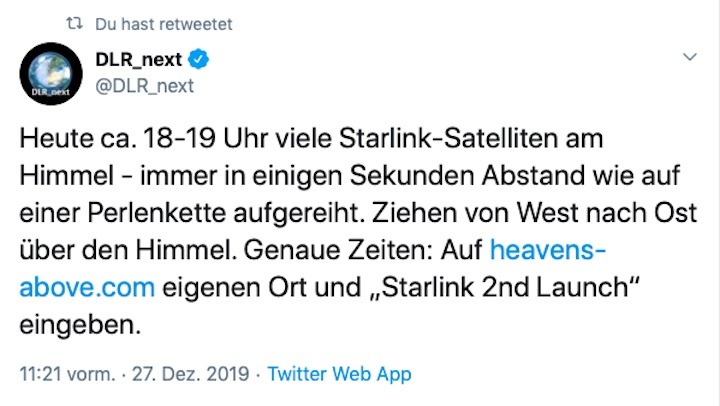
+++
The Year of the Satellite Megaconstellation
In 2019, tiny satellites found all the gaps in space regulation—and flew right on through.
2019 will be remembered for many accomplishments in spaceflight. The first all-female spacewalk, conducted by Christina Koch and Jessica Meir, was a long-overdue milestone. Private spaceflight companies made strides as well, from Blue Origin’s moon lander to SpaceX’s Starhopper test to small satellite launcher Rocket Lab’s plan to recover its rockets, which would make spaceflight even more sustainable.
On the human spaceflight front, we celebrated the 50th anniversary of the moon landing while also asking serious questions about the feasibility of Artemis, NASA’s plan to return to the moon’s surface by 2024. This year will also be remembered as a dance of slow progress and setbacks for Boeing and SpaceX.
Beyond the U.S., Israel and India found both success and failure in reaching the moon with uncrewed missions—success in that much of the feat is in the journey, and failure in that both landers failed to reach the lunar surface intact (though India’s moon satellite is operational). Japan’s Hayabusa2 pointed tiny projectiles at an asteroid and shot it in order to recover samples from beneath the surface; it’s now on its way home from Ryugu. We said goodbye to the Mars Opportunity rover. And who can forget the downright bizarre milestones as well, like the first alleged crime committed in space and the headache of unlicensed tardigrades on the moon?
But the talk of 2019 has been a new kind of space race. Not the battle for supremacy among the major private companies (like those of billionaires Elon Musk, Jeff Bezos, and, to a lesser extent, Richard Branson) and other space-focused startups, but one around something much smaller, with potentially bigger implications: satellite constellations.
Established companies and startups alike are zeroing in on launching large networks of small satellites (generally considered anything under 500 kilograms—in comparison, the Hubble Space Telescope is more than 11,000 kilograms). These are poetically called constellations, and they join most other satellites and the International Space Station in low Earth orbit. These small satellites are cheaper, easier to manufacture, and less expensive to send to space than their larger counterparts. And by working in concert, they can collectively cover a much bigger portion of the Earth than standard satellites, making them perfect for goals such as blanketing the globe in affordable high-speed internet.
Providing low-cost, fast internet to hard-to-reach areas is a worthy goal. It would give people in rural areas and areas with poor infrastructure an affordable way to connect to the internet and participate in the digital economy—in the U.S., roughly 25 million people still don’t have access to broadband internet. And there’s real competition in this space (pun intended): SpaceX has already launched the first satellites of its Starlink constellation, with a proposed final number of 42,000. Earlier this year, Blue Origin announced its intention to create its own constellation for satellite internet (with more than 3,000 satellites), and OneWeb has already launched the first satellites in its endeavor (about 2,500).
These small satellites would be joining an already crowded orbital zone. As of March 2019, there were roughly 1,300 operating satellites in low Earth orbit, along with thousands of pieces of junk—nonworking satellites that haven’t been de-orbited, and other debris (including what might be an empty trash bag). The idea of sending up this many more satellites (which would effectively double the current operational number by the end of 2020) is a real cause for concern for many in the space community.
SpaceX has been a particular focal point for this discussion. That’s partly because its constellation is proposed to be so massive, but also because anything the company does makes headlines. “SpaceX is at the center of this debate because not only are they launching more quickly than other planned megaconstellations, they may launch more than 10 times more satellites in their Starlink constellation than their competitors,” said Laura Forczyk, founder of the space consulting firm Astralytical. Really, though, SpaceX is just the easiest target, bearing the brunt of criticism that is particularly intense because of a massive, systemic problem. “It’s the difference between dealing with a dripping faucet versus turning on the water,” Forczyk said.
The first-ever collision between two satellites occurred in 2009, between a defunct Russian communications satellite and an operational U.S. one.* It’s likely the first of many, considering how crowded it’s getting up there. SpaceX’s Starlink satellites have collision detection software onboard, but earlier this year a Starlink satellite almost collided with one from the European Space Agency in something of a game of chicken: Apparently the anti-collision features worked as expected, but SpaceX decided not to move the satellite, forcing the ESA to take action. “If a satellite collides with something bigger than a dime, it may be seriously damaged,” said Brian Weeden, space junk expert and director of program planning at the Secure World Foundation. “If it collides with something bigger than a baseball, it will likely be catastrophically destroyed into thousands of new pieces.”
This becomes even more complicated when satellites die and become pieces of space junk. SpaceX does have a plan for that: Placing these satellites in an even lower orbit means that once they are offline, the Earth’s gravity will slowly pull them back toward the surface, where they will almost completely burn up in the atmosphere after about five years. Every company planning on launching these types of satellites has a similar de-orbiting plan. But that doesn’t solve the sheer volume problem for when these satellites are operational (and no one knows what the environmental impacts will be of thousands of tiny satellites burning up in the atmosphere). The bottom line is that it’s getting crowded up there.
There’s another issue here as well. Starlink has had an immediate negative impact on Earth-based astronomy—and only a small fraction of the planned constellation has been launched. This particular constellation is much more reflective than expected. Forczyk acknowledged that astronomers regularly compensate for aircraft and satellites in their observations. But new satellite constellations have made the problem much worse. “With Starlink, astronomers are seeing many more streaks than they’re accustomed to, and they worry about a future flood of light streaks in their images,” she said. In the view below, you can see a shot of the night sky, with definite streaks shooting across it. These streaks are Starlink satellites.
SpaceX’s chief operating officer, Gwynne Shotwell, told reporters that the company is working on a fix for the issue: an anti-reflective coating that will make the satellites less bright in the night sky. There’s no guarantee that this fix will work, but Shotwell said, “We’re going to get it done.”
However, these problems weren’t impossible to foresee—astronomers were warning about Starlink’s impact on observation work well before the first satellites launched. And even if SpaceX and others wanted to proceed with their plans without care or caution, satellite launches are ostensibly regulated. Low Earth orbit is an international zone, after all.
Right now, that regulation happens at the national level (though countries do cooperate on issues such as radio frequency use). Governments are responsible for regulating the space activities of companies that operate and launch from within their borders. But that outdated scheme isn’t sophisticated enough to regulate what private spaceflight companies are actually doing in orbit—there are no specific regulations for either space debris or satellite constellations, which leaves corporations to regulate themselves. According to Weeden, there is consensus among experts that satellite licensing requirements need to change. Unfortunately, though, we aren’t quite sure how to deal with the problem. It’s fully baked into the system, not the result of political changes of mood, so until the space community and the organizations that regulate it figure it out, these problems will continue to pile up.
2019 will likely be remembered as the year we really began to understand the costs of unregulated innovation. Let 2020 be the year we tackle the problem head-on at the national and international levels. “The problem of space junk is more challenging, akin to the struggle we have to clean up junk here on Earth,” said Forczyk. “Future generations are counting on us to solve these problems on and around the planet.”
Quelle: Slate
+++
Update: 19.45 MEZ

Inzwischen sind weitere Beobachtungsmeldungen von heute Abend bei uns über Kontaktformular und E-Mail eingetroffen:
Gunzenhausen (mit Foto), Gerolzhofen, Bad Rodach, Schlüsselfeld, Knetzgau, Würzburg.
CENAP-Michelstadt
+++
Über Kontaktformular aus Sulzthal:
Nachricht: => Mindestens 40 Leuchtpunkte steigen im Südwesten bis hoch in den Himmel und verschwinden. 27.12.2019 gegen 18.25 Uhr
+++
Update: 28.12.2019
.

Aufgelaufene Beobachtungsmeldungen bekamen wir über Kontaktformular, E-Mail und Tel-Hotline von gestrigen Abend aus: Merkendorf, Burgoberbach, Weihenzell, Scheinfeld, Bad Windsheim 2x, Hammelburg, Frammersbach, bei Schweinfurt, Blaufelden, Pollenfeld, Zellingen, Grünberg, Schwalmtal, Alsfeld, Eichenzell, Motten, Niederaula, Bad Zwesten, Jesberg, Steinfeld, Arnstein, Rothenbuch, Külsheim,
Hüttenberg, Hohenahr, Burgwald, Rabenau, Gedern, Burgsinn, Uettingen, Bütthard, Adelshofen, Bruckberg, Marktbergel, Heideck, Kipfenberg, südlich von Weißenburg, Eußenheim, Riedenberg, Poppenhausen, Mellrichstadt, Königsberg/Bayern, Forchheim, Ochsenfurt, Auerbach, Bad Neustadt, Wertingen, Ansbach, Donauwörth, Lich, bei Gießen, Bad Kissingen, Dinkelsbühl, Künzelsau, Geiselwind, Schlüchtern, Burgbernheim.
Stand 10.00 MEZ
CENAP-Michelstadt
+++


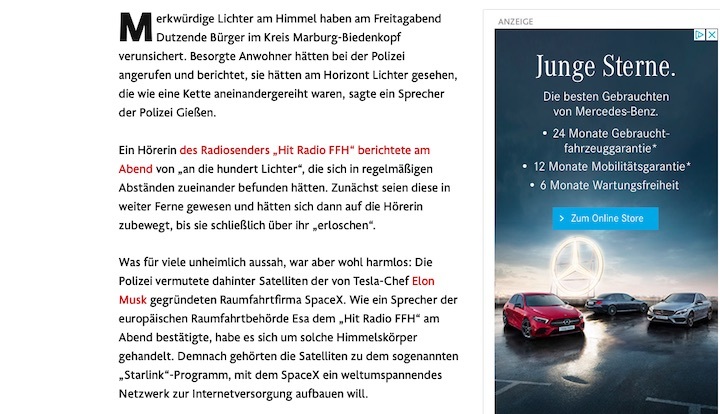


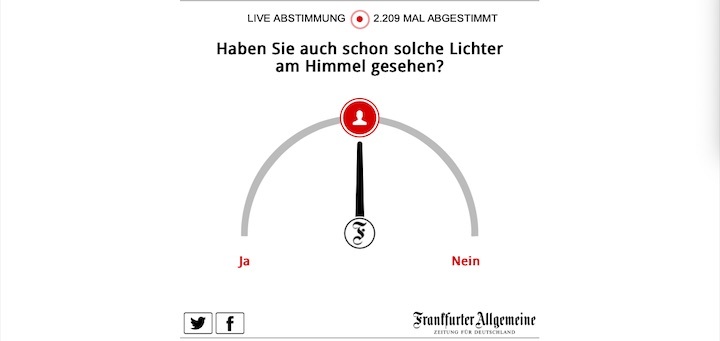

Quelle: FAZ
